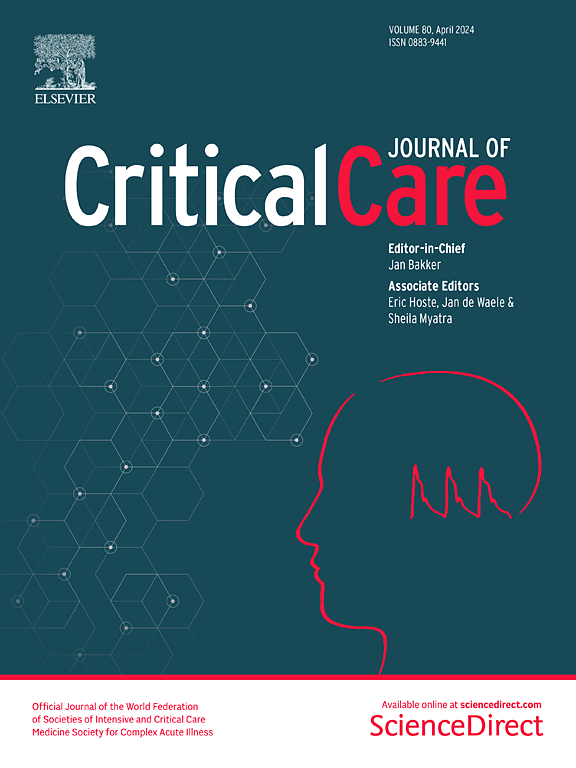作为神经重症监护中肌肉萎缩的预测性生物标志物的加速度计运动特征:一项前瞻性队列研究
IF 8.8
1区 医学
Q1 CRITICAL CARE MEDICINE
引用次数: 0
摘要
缺乏运动和随后的肌肉萎缩在神经重症监护中非常普遍,被认为是重症监护病房获得性乏力(ICUAW)的关键机制。由于缺乏可量化的不运动生物标志物,因此在 ICUAW 综合征诊断中,与其他情况相比,评估不运动的相对重要性变得更加复杂。我们假设,与没有患者积极参与的被动运动相比,主动运动可以作为活动的有效替代物,并有助于预测肌肉萎缩。为了验证这一假设,我们利用无创、固定在身体上的加速度计来计算主动运动的测量值,随后开发了一个机器学习模型来预测肌肉萎缩。本研究是一项单中心、前瞻性、观察性队列研究,是 MINCE 登记(神经重症监护中的代谢与营养,DRKS-ID:DRKS00031472)的一部分。在重症监护病房(ICU)入院后的第3、7和10天,评估股直肌(RFM)相对于基线(第0天)的萎缩情况,并将其作为广义线性混合模型的因变量,该模型采用最小绝对收缩和选择操作器正则化及嵌套交叉验证。在筛选出的 407 名患者中,有 53 名患者(年龄:59.2 岁(SD 15.9),31 名(58.5%)男性)加入了研究,他们共有 91 个可用的加速度计数据集。截至第 10 天,RFM 厚度变化率为 19.5%(标准差为 12.0)。在 12 个人口统计学、临床、营养和加速度计衍生变量中,基线 RFM 肌肉质量(贝塔值 - 5.1,95% CI - 7.9 至 - 3.8)和主动运动比例(活动百分比)(贝塔值 1.6,95% CI 0.1 至 4.9)被选为肌肉萎缩的重要预测因素。将运动特征纳入预测模型大大提高了未见测试数据集的性能(包括运动特征:R2 = 79%;不包括运动特征:R2 = 55%).用固定在大腿上的加速度计测量的主动运动是神经重症患者肌肉萎缩的关键风险因素。反映活动水平的可量化生物标志物可支持更精确的重症监护病房肌肉萎缩表型分析,并可指导有针对性的干预措施,以支持重症监护病房的活动。除了神经重症监护病房外,还需要对这些发现的外部有效性进行研究。DRKS00031472,于 2023 年 3 月 13 日追溯注册。本文章由计算机程序翻译,如有差异,请以英文原文为准。
Accelerometer-derived movement features as predictive biomarkers for muscle atrophy in neurocritical care: a prospective cohort study
Physical inactivity and subsequent muscle atrophy are highly prevalent in neurocritical care and are recognized as key mechanisms underlying intensive care unit acquired weakness (ICUAW). The lack of quantifiable biomarkers for inactivity complicates the assessment of its relative importance compared to other conditions under the syndromic diagnosis of ICUAW. We hypothesize that active movement, as opposed to passive movement without active patient participation, can serve as a valid proxy for activity and may help predict muscle atrophy. To test this hypothesis, we utilized non-invasive, body-fixed accelerometers to compute measures of active movement and subsequently developed a machine learning model to predict muscle atrophy. This study was conducted as a single-center, prospective, observational cohort study as part of the MINCE registry (metabolism and nutrition in neurointensive care, DRKS-ID: DRKS00031472). Atrophy of rectus femoris muscle (RFM) relative to baseline (day 0) was evaluated at days 3, 7 and 10 after intensive care unit (ICU) admission and served as the dependent variable in a generalized linear mixed model with Least Absolute Shrinkage and Selection Operator regularization and nested-cross validation. Out of 407 patients screened, 53 patients (age: 59.2 years (SD 15.9), 31 (58.5%) male) with a total of 91 available accelerometer datasets were enrolled. RFM thickness changed − 19.5% (SD 12.0) by day 10. Out of 12 demographic, clinical, nutritional and accelerometer-derived variables, baseline RFM muscle mass (beta − 5.1, 95% CI − 7.9 to − 3.8) and proportion of active movement (% activity) (beta 1.6, 95% CI 0.1 to 4.9) were selected as significant predictors of muscle atrophy. Including movement features into the prediction model substantially improved performance on an unseen test data set (including movement features: R2 = 79%; excluding movement features: R2 = 55%). Active movement, as measured with thigh-fixed accelerometers, is a key risk factor for muscle atrophy in neurocritical care patients. Quantifiable biomarkers reflecting the level of activity can support more precise phenotyping of ICUAW and may direct tailored interventions to support activity in the ICU. Studies addressing the external validity of these findings beyond the neurointensive care unit are warranted. DRKS00031472, retrospectively registered on 13.03.2023.
求助全文
通过发布文献求助,成功后即可免费获取论文全文。
去求助
来源期刊

Critical Care
医学-危重病医学
CiteScore
20.60
自引率
3.30%
发文量
348
审稿时长
1.5 months
期刊介绍:
Critical Care is an esteemed international medical journal that undergoes a rigorous peer-review process to maintain its high quality standards. Its primary objective is to enhance the healthcare services offered to critically ill patients. To achieve this, the journal focuses on gathering, exchanging, disseminating, and endorsing evidence-based information that is highly relevant to intensivists. By doing so, Critical Care seeks to provide a thorough and inclusive examination of the intensive care field.
 求助内容:
求助内容: 应助结果提醒方式:
应助结果提醒方式:


